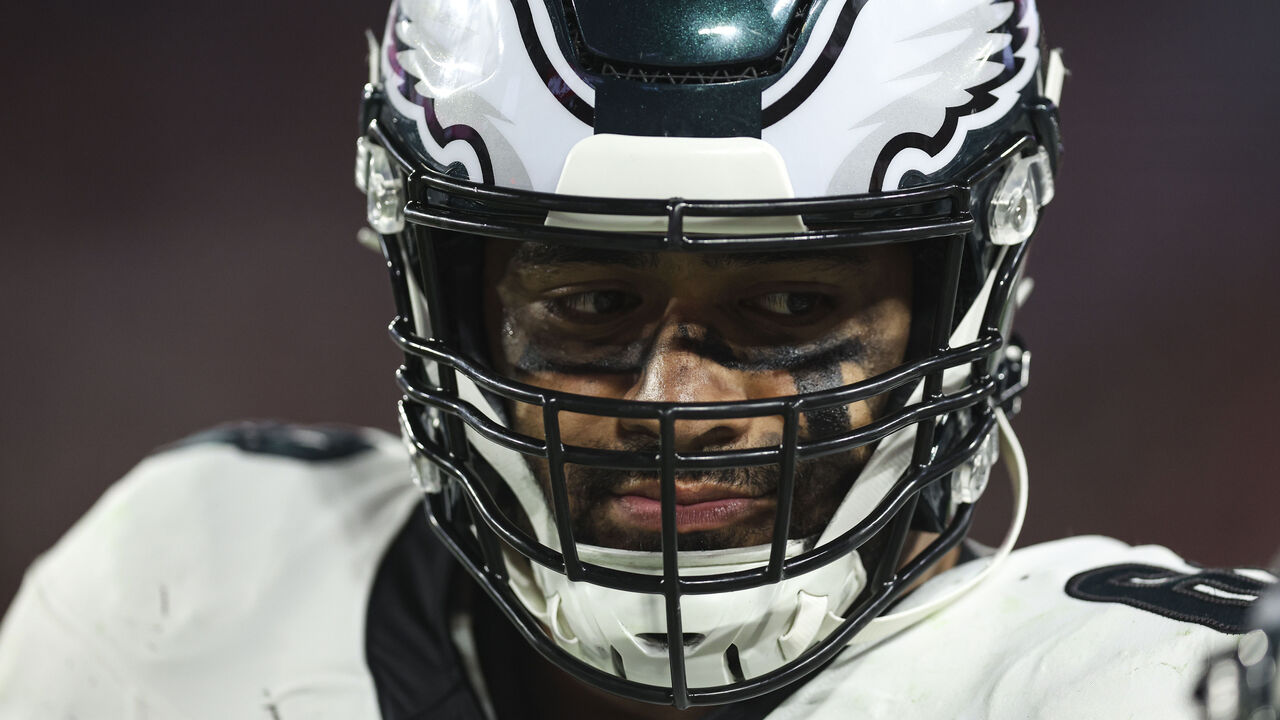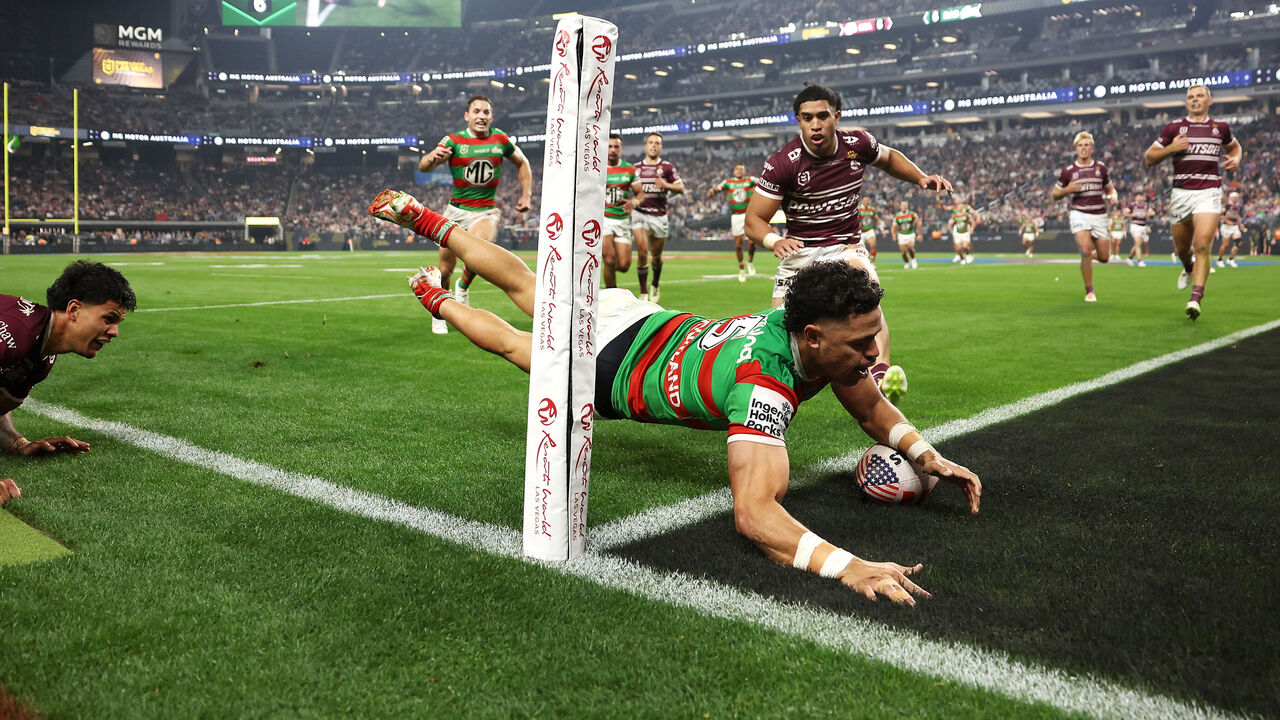How rugby's hip-drop ban became a model for the NFL
In the summer of 2020, Australia's National Rugby League sounded the alarm about a tackle that was ending players' seasons and jeopardizing careers.
A memo to NRL teams pinpointed the problem:
"The concern arises when a defending player heavily impacts the lower legs and feet of attacking players by dropping their body weight on the exposed limbs using their hips, legs, and/or buttocks. This action traps, twists, and contorts muscles, tendons, and joints in an unnatural way."
The hip-drop tackle surfaced in rugby league as a convenient, hazardous way for trailing defenders to floor a speeding ball carrier, whose bones and ligaments buckled under the tackler's dead weight. The NRL classified the play as "dangerous contact" punishable during matches by a penalty kick, a 10-minute trip to the "sin bin," or an ejection, plus a possible suspension or hefty fine.
"We had a pretty steely determination to eliminate it from the game as much as humanly possible," Graham Annesley, the NRL's head of football operations and author of the 2020 memo, told theScore in a recent phone interview.
The NFL, dealing with similar injuries from these tackles, sought guidance from half a world away. League officials consulted with the NRL about how to define and scrap the hip-drop when it started endangering playmakers in the open field.
Over the past two years, hip-drop tackles dinged up Tyreek Hill, Patrick Mahomes, and Geno Smith and broke the fibulas of Mark Andrews and Tony Pollard, who was carted off the field during a Cowboys playoff loss. Jets rookie quarterback Jordan Travis is still recovering from a reckless takedown that cut short his college tenure at Florida State and helped wreck the Seminoles' perfect season and national championship hopes.
The play on which Ravens’ TE Mark Andrews went down and then limped off: pic.twitter.com/UQfYDmZXTT
— Adam Schefter (@AdamSchefter) November 17, 2023
Hip drop tackles are an unacceptable risk to player health and safety.
— NFL Football Operations (@NFLFootballOps) March 28, 2024
More than 20K tackles were reviewed from the past two seasons to identify the type of play this rule addresses, below are examples ⬇️🎥 pic.twitter.com/ihEwWbR516
Deciding the risks were excessive, and with rugby league's example in mind, NFL clubs outlawed the hip-drop by unanimous vote in March. A defender who throws his weight at a runner's lower legs can be flagged for 15 yards and an automatic first down, the standard penalty for a personal foul. How the league polices the new rule and how defenses adapt to it is one of the 2024 season's big storylines.
The ban fanned fierce debate, and it split opinion within teams.
Supporters of a hip-drop crackdown, like John Harbaugh, Andrews' head coach in Baltimore, argued that tacklers shouldn't use such a risky technique. Former Ravens linebacker Patrick Queen joined a chorus of critics who think it overly constrains the defense and will hasten the NFL's metamorphosis into a no-contact game.
"I hate that Mark is hurt. Prayers for him. But at the end of the day, we play football," Queen said after Andrews was injured last season, per Ravens team reporter Ryan Mink. "I don't think a hip-drop tackle is that bad of a thing. How else do you want us to tackle? Just let the guy run past you?"
2 hand touch gone be next lmao
— 🦈 (@Patrickqueen_) March 25, 2024
Just fast forward to the belts with flags on them… https://t.co/yToh5XKVMS
— JJ Watt (@JJWatt) March 25, 2024
Breaking news: Tackling Banned
— Jev (@quickdrawjev) March 25, 2024
Competition committee doesn’t care about defense. Every year they make it harder for us to succeed 🤦🏾♂️
— Joshua Metellus (@NoExcuses_23) March 25, 2024
The view in Australia is that the NRL product didn't suffer. Serious injuries declined as tacklers continued to grip the ball carrier and swivel their weight toward his body but adjusted to hit the grass first before contacting the opponent's legs. The NRL's three-part definition of a hip-drop tackle - a grab, a twist, and a drop - singled out the third element as the threat to player safety.
"It became apparent to us that there were certain attributes of these tackles that could be prevented," Annesley said. "What we're trying to avoid is the bulk of the body weight falling directly onto the leg as the first point of contact. If the body weight hits the ground before the leg, it means the ground absorbs most of the weight."
Trends in football and rugby league - the 13-player game resembles but is distinct from rugby union - made hip-drop tackles useful. It helped NFL defenders avoid penalties for helmet hits, The Athletic's Mike Jones pointed out. Increases in size and strength throughout rugby mean even fleet-footed wingers are massive nowadays and hard to haul down, said Brien Seeney, an independent NRL injury analyst and musculoskeletal sports physiotherapist in Brisbane.
The outcry about the NFL ban was understandable. Defenders don't want to lose access to a tactic that stops a runner in his tracks.
"But that's true for every dangerous tackle," said Seeney, who breaks down rugby injuries on his popular @nrlphysio social media accounts. "In rugby, we have high tackle bans where you can't hit a player in the head. Sometimes, the easy option to stop a player from scoring a try, or a touchdown in the NFL, would be to hit them in the head or do a horse-collar tackle. Just because it's the easiest way doesn't mean it's the only way."
Jye Gray ruled out at half time after succumbing to an ankle injury.
— NRL PHYSIO (@nrlphysio) May 2, 2024
Hip drop tackle mechanism - contact causes foot to turn out bringing concern for a syndesmosis injury. Moderate to high grade sprain would be at least 3-4 weeks recovery so hopefully not as bad as it looks. pic.twitter.com/OoFuRJl1W0
Hip-drops cause awkward, painful pileups. The NFL's analysis of tens of thousands of plays from the past two seasons showed they injure lower extremities "at a rate 20 times higher than other tackles," the league noted when approving the ban. The review found 15 players, or close to one a week, missed time in 2023 with a hip-drop injury.
Before removing the hip-drop, the NFL contacted Annesley to ask questions about rugby league's process, rules, and results.

The NRL described the hip-drop's three simple steps - the grab, twist, and drop - in all communications with clubs and fans to hammer home how it could be avoided. To change tackling habits, some coaches emphasized leading with a shoulder and driving through the ball carrier's body.
Seeney said hip-drops in Australia were widely considered worth banning because of a rash of long-term injuries, though skeptics initially wondered how the NRL would distinguish and define the tackle. Detractors, including ex-players in the media, framed those injuries as an acceptable consequence of play.
"There were people who felt - and maybe still do, in some cases, probably in the minority - that this was just an unfortunate aspect of playing the game, and when you're trying to tackle players and stop their forward progress, there are things that can go wrong that are nothing more than accidents," Annesley said.
In response, he added, "We can't eliminate all injuries because it is a tough, physical game. But we as administrators have a responsibility to make the game as safe as possible."
The NRL's oldest teams were founded in Sydney more than a century ago when rugby league, a British creation, was introduced to Australia, where it's now the most-watched sport on TV. The ongoing NRL season kicked off in March with a first-of-its-kind doubleheader at Allegiant Stadium, home of the Las Vegas Raiders. Next season will open in Vegas, too.
Football and rugby league are both ferocious, share a common goal (elude tackles to reach the end zone), and sporadically inspire career changes.
Eagles left tackle Jordan Mailata was an NRL South Sydney Rabbitohs youth prospect before he switched sports at age 20 through the NFL international pathway program. Two-time NRL MVP Jarryd Hayne, who played on offense and special teams for the 49ers in 2015, infamously muffed his first punt return.


The differences between the games are obvious: Rugby doesn't have helmets, pads, forward passes, timeouts, or constant lengthy pauses. Rugby league players attack and defend with duties changing as possession does, which happens when the defensive team records six tackles or the offense punts the ball to swing field position.
After a completed tackle, all but two defenders must retreat 10 meters (11 yards) before pursuing the ball again. Stopping the offense's progress is key to victories. One effect of the hip-drop ban, which NFL tacklers will hate, is that runners gain a little extra distance when they're wrapped up cleanly and fall forward.
"I don't think anyone who pays attention to this denies that it'll make life harder for the defending player. It will," said Seeney, an NFL fan who follows along as closely as possible from Brisbane. "(But) it hasn't killed the game over here. They're two very different games in terms of the way players tackle, but the (NRL) game still exists. It hasn't resulted in the game being wholly different, and I doubt it will for the NFL."
The NFLPA objected to a hip-drop ban based on concerns ranging from a lack of player input to a distaste for fines to the fear that it would confuse everyone in the stadium, including officiating crews.
Falcons CEO Rich McKay, the NFL competition committee co-chairman, acknowledged it'd be difficult to spot and flag the tackle accurately in real time.
Rich McKay: “Do we have a problem? The answer was yes.”
— Ian Rapoport (@RapSheet) March 25, 2024
“This will be a hard one to call on the field, you have to see every element of it. We want to make it a rule so we can deal on the discipline during the week.” https://t.co/84Ny0FEq8s
Rugby referees benefit from a second set of eyes. Off-site match officials at the NRL's "bunker," a centralized office in Sydney, review tackles from all angles in high definition and speak to referees during game stoppages to flag overlooked offenses. Like most penalties, hip-drop calls in the NFL aren't subject to challenges or instant replay.
Annesley said he'd keenly observe the start of the NFL season to see how the crackdown plays out, conceding controversies will be inevitable. He thinks his league swayed the opinion of wary Australians over the past few years, and he was pleased to share takeaways from the experience.
"I'd be happy if we played some small role in making the game of the NFL safer," Annesley said. "Hopefully, the players are the beneficiaries of that. That's the sole intent: try to keep the players on the field, able to perform for the fans, and not have them sitting on the sideline recovering from injuries."
Nick Faris is a features writer at theScore